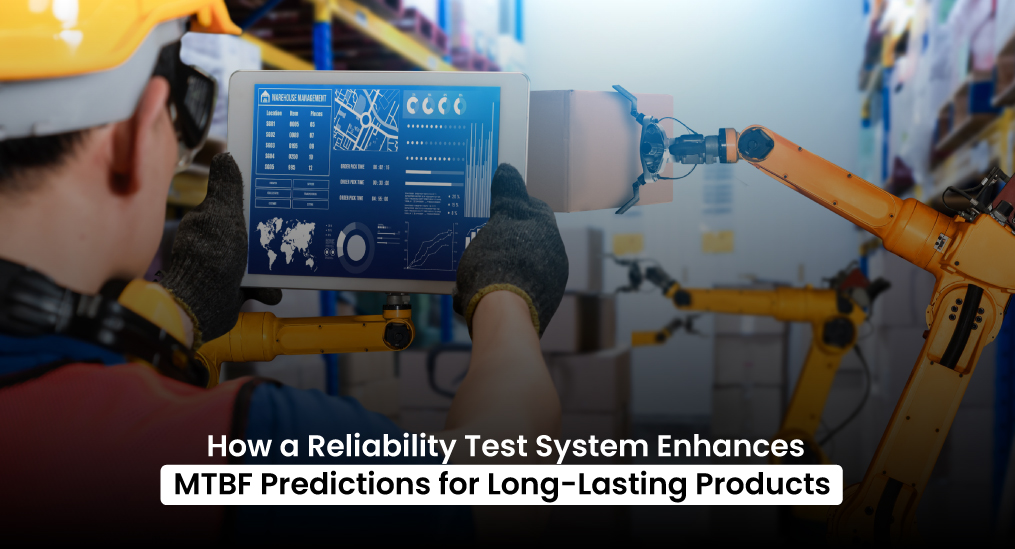When it comes to building high-quality, long-lasting products, reliability is everything. Whether you’re creating industrial machinery, consumer electronics, or automotive components, your customers expect products they can count on. This is where a Reliability Test System and Mean Time Between Failures (MTBF) come into play.
MTBF is a critical metric that predicts the average time a product will operate before experiencing a failure. But how can manufacturers ensure their MTBF predictions are accurate and reliable? The answer lies in employing a Reliability Test System (RTS).
This blog will explore MTBF’s importance, the role of reliability testing, and how implementing advanced test systems can refine MTBF predictions, ensuring superior product reliability.
Understanding MTBF and the Role of a Reliability Test System
What is MTBF?
MTBF, short for Mean Time Between Failures, is a statistical measure of a product’s reliability. It estimates how long, on average, a product will function before encountering a failure.
For example:
- A car battery with an MTBF of 200 hours suggests that if multiple batteries are tested, the average operating time between failures across all units would be 200 hours.
Why MTBF Is Crucial
- Customer Satisfaction: Products with higher MTBF values are less likely to fail, ensuring customer trust and loyalty.
- Lower Costs: Higher reliability means fewer warranty claims and lower repair costs.
- Competitive Advantage: Products with proven reliability often lead the market in adoption and reputation.
However, calculating accurate MTBF requires sophisticated testing and analysis—which brings us to the concept of reliability testing.
The Role of Reliability Testing in MTBF Predictions

What Is Reliability Testing?
Reliability testing involves evaluating a product’s performance under controlled conditions to assess its behavior, durability, and likelihood of failure over time. These tests simulate real-world usage scenarios to identify weak points and optimize design.
Why Reliability Testing Matters for MTBF
- Generates real-world data to improve MTBF predictions.
- Identifies flaws in materials, design, or manufacturing processes.
- Supports compliance with industry regulations by proving product reliability.
Imagine testing a smartphone battery under extreme temperature conditions. Without proper reliability testing, a flaw in the design could cause overheating, leading to unexpected failures. Testing catches these issues before they reach the consumer.
This is where Reliability Test Systems (RTS) shine.
What Are Reliability Test System and Their Benefits?
A Reliability Test System (RTS) is an advanced testing platform designed to assess product durability. It integrates automated processes, sensors, and analytics to deliver precise, real-time performance insights.
Key Benefits of RTS
- Automation: Reduces manual error and accelerates testing processes.
- Real-Time Data Analysis: Provides immediate insights into performance metrics.
- Consistency: Offers standardized testing conditions, ensuring accurate results.
- Customizability: Allows tailoring of test scenarios specific to different products.
- Predictive Insights: Leverages AI and advanced algorithms to refine MTBF calculations.
For manufacturers, adopting a Reliability Test System doesn’t just improve product reliability; it transforms how they approach product innovation.
How an RTS Improves MTBF Predictions

Here are specific ways Reliability Test Systems enhance MTBF predictions for long-lasting products.
1. Comprehensive Stress Testing
RTS platforms normalize extreme environments (e.g., temperature fluctuation, humidity, or mechanical stress) that mimic real-world conditions. This allows precise data capture on how and when failures occur.
2. Enhanced Failure Data Collection with Advanced Reliability Test System
RTS systems collect machine-generated failure data, reducing guesswork. Advanced sensors pinpoint exactly when, where, and why components may fail.
3. Sophisticated Algorithms for Prediction Models
Modern RTS platforms leverage artificial intelligence (AI) and machine learning to analyze data trends. These models predict failure rates with higher accuracy, improving MTBF precision.
4. Automated Spotting of Hidden Defects
Small defects often go unnoticed during visual inspections, but RTS systems can identify potential failures at a microscopic level during routine testing.
5. Faster Iterative Design Improvements
By offering immediate feedback, RTS platforms allow teams to make real-time design updates, reducing product development cycles and ensuring reliability before mass production.
The use of an RTS means you no longer have to rely on estimated predictions alone; instead, you gain actionable insights grounded by comprehensive testing and data analytics.
Real-World Examples of RTS Impacting MTBF

Example 1: Automotive Industry
A global car manufacturer implemented an RTS to test various engine components under high temperatures and vibrations. By capturing in-depth failure rates, they identified a subtle design flaw in the fuel injection system, which caused premature wear. Fixing the flaw increased the MTBF of their engines by 32%.
Example 2: Consumer Electronics
A tech company deploying RTS discovered that the plastic casing of its flagship smartphone degraded after prolonged exposure to UV light. Addressing this issue boosted the MTBF prediction from 18 months to 24 months, improving consumer trust.
Example 3: Medical Devices
A medical device firm used RTS to evaluate the durability of portable glucose meters. By analyzing stress test data, the company extended the meter’s lifetime, satisfying regulatory bodies and increasing market share.
These examples demonstrate how RTS ensures product reliability and enhances MTBF predictions in various industries.
Reliability Test System: Your Key to Reliable Products and Accurate Results
When it comes to achieving superior product reliability, there’s no substitute for advanced testing practices. A Reliability Test System (RTS) is the ultimate tool to ensure accurate MTBF predictions, reduce failure rates, and differentiate your brand in a competitive market.
If you’re ready to create products that stand the test of time, consider investing in an RTS. Not only will it empower your team to produce long-lasting, reliable products, but it will also secure customer loyalty, cut costs, and amplify your brand reputation.
At Relteck, we specialize in helping businesses design and implement powerful reliability testing solutions. Take the first step in enhancing your product development today. Contact us to learn more!






